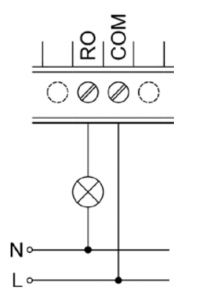This is an old revision of the document!
Relay outputs are wired to ROx, or ROy.x and COM screw terminals and serve for switching two-states devices. They are capable of switching AC or DC voltage. The COM terminal (which can be shared by two relays) serves for connection of the switched voltage (and others) by the relay to the ROx, or ROy.x terminal. Relays are connected in NO (normally open) states, meaning that by default there is no contact between terminals.
The state (On/Off) of each relay is indicated by a LED with a corresponding label. Overload and overvoltage protection should be provided externally by a circuit breaker (ideally one for each output). Nominal current and circuit breaker type should be selected according to the load and its characteristics concerning the maximum current on the output.
Note:
If an inductive load is connected (eg. electric motors, relay coils, contactors or even the cables in extensive electric installations), we recommend protecting the relay outputs by a corresponding external element (eg. varistor, RC circuit or a suitable diode).
If a capacitive load is connected (eg. power sources of LED lights), we recommend protecting relay contacts against inrush current by connecting a corresponding thermistor to the relay's output.
